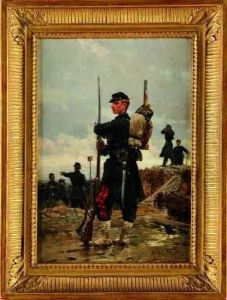Alphonse Neuville Paintings
Alphonse de Neuville was a prominent French Academic painter and illustrator known for his detailed and dramatic depictions of military subjects, particularly those related to the Franco-Prussian War. Born on May 31, 1835, in Saint-Omer, Pas-de-Calais, France, Neuville showed an early interest in the arts, a passion that would guide his entire career. Despite initial opposition from his family, who preferred he pursue a career in law, Neuville's determination to become an artist led him to Paris, where he enrolled at the École des Beaux-Arts. He studied under François-Édouard Picot, a well-regarded painter of his time, which grounded Neuville in the academic painting tradition that would dominate his artistic style.
Neuville's career took a significant turn during the Franco-Prussian War (1870-1871), where he served as an army correspondent. This experience provided him with firsthand accounts and observations of war, which became the primary subject matter for his art. His paintings from this period, such as 'The Defence of Rorke's Drift' (1880), 'The Spy' (1880), and 'The Last Cartridges' (1873), are celebrated for their realism, attention to detail, and ability to convey the intense emotions and chaos of battle. These works not only earned him critical acclaim but also resonated with the French public, who were grappling with the aftermath of the war and the loss of Alsace and Lorraine to Germany.
Beyond his war scenes, Neuville was also an accomplished illustrator, contributing to several periodicals and books of the time. He collaborated with another famous war artist, Édouard Detaille, on an illustrated history of the French army, which further cemented his reputation as a leading military artist of his era. Despite his focus on military themes, Neuville's work is distinguished by its humanism. He often depicted the valor and suffering of the common soldiers rather than glorifying war itself.
Neuville's contributions to French art were cut short by his premature death on May 18, 1885, in Paris. Today, his works are held in high esteem and can be found in many prestigious museums and collections around the world. They continue to be studied for their artistic merit and as historical documents that offer insight into the Franco-Prussian War and the broader European military conflicts of the late 19th century. Neuville's legacy is that of a meticulous chronicler of war, whose paintings serve as a poignant reminder of the human cost of conflict.
